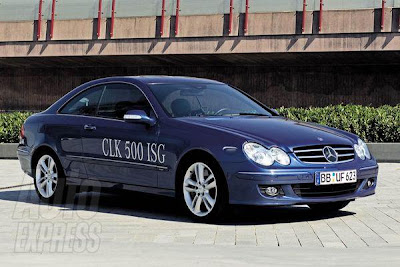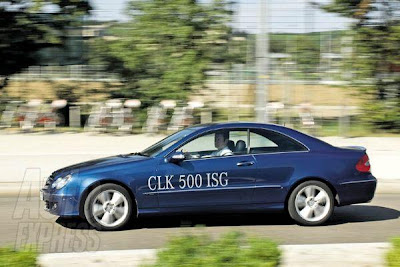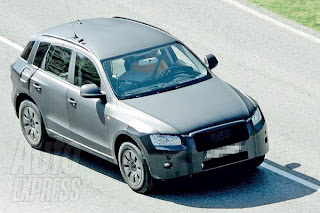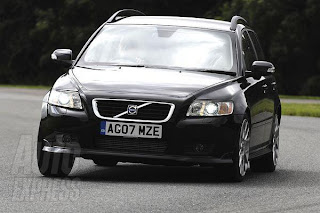When it comes to boosting efficiency in petrol engines, Mercedes is playing catch-up. Premium rival Lexus already has hybrid cars, while BMW offers regenerative braking to improve fuel economy on several models.
But the three-pointed star is working hard to regain ground – and Auto Express has driven its latest development: a CLK 500 with ISG technology.
The initials stand for Integrated Starter/Generator, and in lay terms, the set-up is a stop-start system. A disc-shaped electric motor is added between the engine and automatic transmission, while a secondary battery is charged by regenerative braking and offers a power boost during hard acceleration. The main advantage is that this layout is smaller and lighter than a hybrid transmission.
For the driver, it means fuel economy is up 10 per cent from 24.8mpg to 27.3mpg, while CO2 output is estimated to drop by a similar proportion. The stop-start technology cuts the engine when you come to a halt, and fires it up as soon as your right boot comes off the brake. By the time you are pressing the accelerator, it’s as if the V8 has been running all the time.
The stop-start technology cuts the engine when you come to a halt, and fires it up as soon as your right boot comes off the brake. By the time you are pressing the accelerator, it’s as if the V8 has been running all the time.
The powerplant also switches off if you shift the auto box into Park mode.
At least that’s how it’s supposed to work. But in the 30-degree heat of our urban drive in Germany, it didn’t. Despite having several opportunities to cut out as we stopped at traffic lights and junctions, it failed every time. We thought the system wasn’t working properly, but later learned it was because we had turned the CLK’s air-conditioning on. Apparently, the car prioritises driver comfort over saving the planet. On a second run with the cooling system switched off, the ISG technology worked fine.
We thought the system wasn’t working properly, but later learned it was because we had turned the CLK’s air-conditioning on. Apparently, the car prioritises driver comfort over saving the planet. On a second run with the cooling system switched off, the ISG technology worked fine.
Arguably, the Mercedes stop/start isn’t as clever as it thinks it is. Yes, it can cut the engine to save fuel, but similar devices offered by rival manufacturers switch off when they realise you are coming to a halt. That means owners get every last mile from the fuel tank by freewheeling to a standstill. What’s more, bosses won’t offer the ISG technology until 2009.
Car Review:Mercedes CLK 500 ISG
Lexus RX Getting Bigger And Seven-seat RX coming
Bigger is better at Lexus. Our exclusive picture shows that the next RX will be larger than the current model – and it could even be offered as a seven-seater for the first time.
Despite this, the Japanese firm is likely to take a conservative approach to the newcomer’s styling. It will feature swept-back headlamps and the trademark Lexus grille, while the distinctive curved roof of the existing car will also be retained. Our spy shot (below) shows that the replacement’s underpinnings are already being fine-tuned in a test mule wearing the current SUV’s body. At first glance, it looks like any other RX, but close inspection reveals that the rear lights no longer sit flush with the bodywork. That’s because the panels have been widened to account for the new platform’s bigger dimensions. This added size could pave the way for an optional third row of seats, which would put the Lexus up against BMW’s X5 when it arrives in dealers in 2009.
At first glance, it looks like any other RX, but close inspection reveals that the rear lights no longer sit flush with the bodywork. That’s because the panels have been widened to account for the new platform’s bigger dimensions. This added size could pave the way for an optional third row of seats, which would put the Lexus up against BMW’s X5 when it arrives in dealers in 2009.
The new 4x4 likely to debut at that year’s Tokyo Motor Show because, although the biggest market for the RX is the US, the model will be the first SUV in Japan to wear a Lexus badge. The current generation is called the Toyota Harrier in its home market. Recent Post:
Recent Post:
+ New Audi Q5 Shapes Up
+ Volvo V50 D5 SE Sport Mildly Revised Load Lugger Looks Better, But Does It Load Better?
+ BMW X5 GETS IT RIGHT: Luxury SUV a big improvement from earlier generation
+ 2008 BMW 650i Coupe and Convertible Preview
+ 2008 Mercedes-Benz C-Class: A Step In The Right Direction
+ It's Ferrari's new 'Scud' missile
+ 2007 BMW Alpina B7
+ Full Test: 2007 FPV Ford Falcon GT A Four-Door Mustang From Down Under
+ 2008 Porsche Cayenne S
+ 2007 Porsche 911 Carrera 4S Cabriolet
+ Fleet Update: 2007 Audi Q7 4.2
New Audi Q5 Shapes Up
Take a look at the best pictures yet of Audi’s Q5 compact SUV. The German firm’s engineers are putting the finishing touches to the model ahead of its unveiling at next year’s Geneva Motor Show.
A rival to the BMW X3, Land Rover Freelander and forthcoming Mercedes MLK, the Audi is based on the same platform as the A5 coupé and next-generation A4. These pictures reveal that the Q5 takes its styling inspiration from the bigger Q7. Inside, there will be enough room to carry five adults in comfort, while the cabin is derived from the new A5. The Q5 will have limited off-road ability, and all models will feature a raised ride height and quattro four-wheel drive as standard. But with a chassis tuned for on-road handling, it will be sporty and fun to drive.
Inside, there will be enough room to carry five adults in comfort, while the cabin is derived from the new A5. The Q5 will have limited off-road ability, and all models will feature a raised ride height and quattro four-wheel drive as standard. But with a chassis tuned for on-road handling, it will be sporty and fun to drive. Under the bonnet, the Q5 will be offered with 2.0-litre turbo and 3.2-litre V6 petrol engines, plus 2.0-litre and 3.0 litre TDI diesels. There is also the chance Audi will make a high-performance 4.2-litre V8-powered model.
Under the bonnet, the Q5 will be offered with 2.0-litre turbo and 3.2-litre V6 petrol engines, plus 2.0-litre and 3.0 litre TDI diesels. There is also the chance Audi will make a high-performance 4.2-litre V8-powered model.
When the Q5 goes on sale in mid-2008, the range will start from around £30,000. It isn’t the only new Audi SUV on the way – our spies have snapped a Q7 flagship, too. This has a 500bhp 6.0-litre V12 TDI diesel, an aggressive nose with deep air intakes and should cover the 0-60mph sprint in 5.5 seconds.
It isn’t the only new Audi SUV on the way – our spies have snapped a Q7 flagship, too. This has a 500bhp 6.0-litre V12 TDI diesel, an aggressive nose with deep air intakes and should cover the 0-60mph sprint in 5.5 seconds.
The model will be revealed at the Frankfurt show next month.
+ BMW X5 GETS IT RIGHT: Luxury SUV a big improvement from earlier generation
+ 2008 BMW 650i Coupe and Convertible Preview
+ 2008 Mercedes-Benz C-Class: A Step In The Right Direction
+ It's Ferrari's new 'Scud' missile
+ 2007 BMW Alpina B7
+ Full Test: 2007 FPV Ford Falcon GT A Four-Door Mustang From Down Under
+ 2008 Porsche Cayenne S
+ 2007 Porsche 911 Carrera 4S Cabriolet
+ Fleet Update: 2007 Audi Q7 4.2
Volvo V50 D5 SE Sport Mildly Revised Load Lugger Looks Better, But Does It Load Better?
Sporty, stylish and practical – the new Volvo V50 is as versatile as a Swiss army knife. But can it cut through the competition on UK roads?
The Swedish brand has revised its smallest estate range with the addition of two new engines. Alongside a fresh entry-level 2.0-litre petrol unit, there’s now the option of the potent D5 diesel powerplant for the first time.
Cosmetic revisions are limited, and only true Volvo fans will spot the wider grille, plus the revamped light covers and bumper at the front. It’s much the same story at the back, where new lamp clusters featuring LED bulbs are the only obvious difference.
None of this is bad news, though, because the V50 has always been a handsome estate. Unfortunately, it’s never been a particularly big one – and, disappointingly, the modest 417-litre boot capacity is the same as on the previous model. At least it expands to a more useful 1,307 litres with the rear seats folded down.
Opt for the SE Sport trim of the car we drove, and you get large 18-inch wheels and a full bodykit to help set your V50 apart from lesser variants. The cabin also features leather upholstery and some of the most comfortable seats on the market.
Inside, storage is improved, thanks to large door bins, while solid build quality and superior materials reinforce the V50’s premium feel. Our test car also had the advanced Blind Spot Information System (BLIS). At £650 it’s not cheap, but the clever set-up alerts the driver to objects in the over-the-shoulder blind spot.
Our test car also had the advanced Blind Spot Information System (BLIS). At £650 it’s not cheap, but the clever set-up alerts the driver to objects in the over-the-shoulder blind spot.
Rear-facing digital cameras mounted in the door mirrors monitor the areas where your vision is restricted, and flash warning lights positioned on the A-pillars if it’s unsafe to change lanes. The same system is available in the XC90, and although it takes some getting used to, it eases some of the strain of motorway driving. In comparison, the D5 engine is a familiar piece of technology that has been tried and tested in cars across the Volvo model range. The power output has been reduced for the V50, although it still produces 178bhp and 350Nm of torque – which is enough to propel the revised load-lugger from 0-62mph in 7.9 seconds.
In comparison, the D5 engine is a familiar piece of technology that has been tried and tested in cars across the Volvo model range. The power output has been reduced for the V50, although it still produces 178bhp and 350Nm of torque – which is enough to propel the revised load-lugger from 0-62mph in 7.9 seconds.
Thanks largely to its five-cylinder configuration, the oil-burner also has a distinctive growl – but under full throttle the noise is all too noticeable. Once cruising, refinement improves, making the Volvo a relaxed motorway cruiser. Sport models like ours come fitted with a chassis package designed to improve handling – although as the V50 shares underpinnings with the Ford Focus, it’s stable and sure-footed anyway. Unfortunately, the steering feels a little numb. Still, the Volvo is composed in bends, and despite its large 18-inch alloy wheels, the V50’s ride is impressive. Combine this with the brand’s smooth Geartronic automatic transmission, and the estate is a soothing car to drive.
Sport models like ours come fitted with a chassis package designed to improve handling – although as the V50 shares underpinnings with the Ford Focus, it’s stable and sure-footed anyway. Unfortunately, the steering feels a little numb. Still, the Volvo is composed in bends, and despite its large 18-inch alloy wheels, the V50’s ride is impressive. Combine this with the brand’s smooth Geartronic automatic transmission, and the estate is a soothing car to drive.
Although lower-spec variants argu-ably make more sense than the top-of-the-range SE Sport, the revised V50 is a desirable family car. Overall, it’s a solid alternative to contenders from the likes of Honda, Saab and BMW.
But it’s not cheap. If you want your Volvo with as much equipment as the option-laden model here, you will have to spend £30,240! It’s not difficult to find cheaper alternatives with more tempting prices.
+ BMW X5 GETS IT RIGHT: Luxury SUV a big improvement from earlier generation
+ 2008 BMW 650i Coupe and Convertible Preview
+ 2008 Mercedes-Benz C-Class: A Step In The Right Direction
+ It's Ferrari's new 'Scud' missile
+ 2007 BMW Alpina B7
+ Full Test: 2007 FPV Ford Falcon GT A Four-Door Mustang From Down Under
+ 2008 Porsche Cayenne S
+ 2007 Porsche 911 Carrera 4S Cabriolet
+ Fleet Update: 2007 Audi Q7 4.2
[source:http://www.autoexpress.co.uk/carreviews/firstdrives/209707/volvo_v50.html]